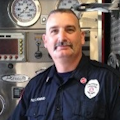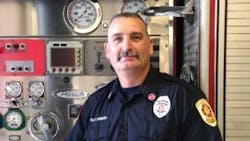In any typical month, Illinois Fire Fighter Peer Support receives a half dozen calls for help. That includes a mix of calls from a crew that had a rough call, a department that has had a string of bad calls, or like most requests, an individual looking for help. While we don’t track specific numbers, the two most common requests we receive are related to addiction and anxiety. These I believe are most often brought on by post-traumatic stress (PTS).
Before I get ahead of myself, I would like to clarify that I am not talking about post-traumatic stress disorder (PTSD) but PTS, which many first responders deal with due to the trauma we witness. As much as first responders like to pride ourselves on being ready for anything that comes our way and taking difficulties head on, we have for the most part dropped the ball on both PTSD and PTS.
I have had many conversations with first responders struggling with PTSD, many of whom are no longer working because of the effects. I cannot emphasize strongly enough that PTSD is complicated and requires a professional to truly diagnose the symptoms. Professional diagnosis is the only way someone struggling with PTSD can be certain to receive appropriate care. One of the most helpful places I have found when trying to understand PTSD is the U.S. Department of Veterans Affairs website. The user-friendly site has an abundance of great information.
I have written a quick breakdown of the four categories of symptoms of PTSD:
- Re-experiencing symptoms
- Avoidance symptoms
- Hyperarousal
- Negative thoughts or feelings
To receive a diagnosis of PTSD, an individual must have all of the following for at least one month:
- At least one re-experiencing symptom
- At least one avoidance symptom
- At least two negative thoughts or feelings symptoms
- At least two hyperarousal symptoms
Again, I cannot stress strongly enough how important it is to seek professional help if you feel you are struggling with these symptoms. All too often I have first responders tell me they are self-diagnosed with PTSD. That statement is usually followed with an admission of not seeking professional help. My guideline for seeking help is one simple question: Do you have symptoms that are interfering with your personal or professional life?
Please, if you think you have PTSD, don’t try to handle it yourself; seek professional help.
While most of us will likely not experience PTSD, I felt it important to include a brief overview because it’s impossible to be a first responder without being affected by some of these symptoms at different times. And some symptoms of PTSD are also signs of PTS, which is often referred to as a normal reaction to an abnormal situation.
Close to Home
As first responders, whether full-time career, part-time, or volunteer, we see things we cannot forget. We like to think we are strong, and those things are not going to affect or change who we are. Unfortunately, this couldn’t be further from the truth. The reality is we don’t even realize how these symptoms have affected our lives.
As an example, when I read about avoidance symptoms, I was convinced that I didn’t avoid anything. After all, I’m a firefighter; I challenge everything head on. But then I stopped to really think about this and realized, as simple and insignificant as it might seem, I had been avoiding the chainsaw on our engine. A year earlier, I had used that saw to cut limbs from a tree that contained human remain fragments.
On the surface, avoiding the saw may not seem like a big deal, but then I had to ask myself what else I avoiding in my life? The bigger question was what was I avoiding in my home life? How was this affecting my interactions with my wife and my kids?
It’s not just avoidance that affects us. After I lead an outreach class, a man came up to me and explained how he watched his granddaughter receive a new bike the previous week. All he could think about was the call he responded to where a kid was hit by a car while riding his bike.
The category I most often recognize when talking with other first responders is hyperarousal. I am always convinced everything is going to go wrong; therefore, I plan accordingly. My wife and I have a small travel trailer that we love to take trips in. I am convinced—anxious, really—that every time we leave on a trip, something is going to go wrong, so I bring enough tools and supplies to rebuild most anything. In reality we have never broken down or been stranded. But I know I’ll still be bringing everything on our next trip.
Facing Hard Truths
So, while many people are concerned about PTSD, and that’s important, we have been ignoring the PTS that affects all of us in many ways we don’t even realize.
Imagine you receive what you would consider a small cut. It’s nothing, so you wipe the cut and move on. It’s nothing, and besides, you have had plenty of cuts, no big deal. A couple days later you notice the area around the cut feels warm and looks swollen and red. Do you ignore the fact that you likely have an infection, or do you treat it so that it doesn’t get worse?
This really is where we are with PTS. While we all have these symptoms, we continue to ignore them and assume it will just get better. We tell ourselves, “I’ve got this,” and just keep pushing forward. Rather than treating our wound, we jump into the next pile of dung and add to our infection.
What if we changed what we do? I know, I just said the forbidden word, change. Every now and then I will have someone come up to me and say that people need to just “suck it up.” My immediate response is, “How has that been working out for us?” It’s no secret that suicide rates for first responders are out of control. One report showed that in 2017, twice the number of firefighters died by suicide than in the line of duty. We have way too many members self-medicating using alcohol. All the while we just keep on keeping on.
Instead, I propose we need to change our methods of how we think about and react to the trauma we see.
What is the solution? I think there are a few options, some of which should include:
- An annual mental health checkup.
- Mental health training so we can better recognize the symptoms early rather than later when they are harder to treat.
- Resiliency training to help first responders be mentally strong so that when we are confronted with trauma, we are able to process the events in a healthy way.
Obviously as the Executive Director of one of the leading peer support teams in the country, I am going to talk about the importance of peer support. In short, trauma causes isolation, while peer support creates connection. When we have experienced a trauma we feel alone, as if we are the only one who has had this experience. If the atmosphere we’re in is one of “suck it up,” the feeling of isolation only grows. Through peer support, we can stand beside our brothers and sisters.
Our model is simple:
- Listen: Active listening skills are vital.
- Relate: I have not seen it all, but nothing surprises me.
- Validate: That sounds tough. I don’t know that I would have slept after that call, either.
Pay attention to those you work with. Ask them how they are doing. Ask twice and mean it. Be ready to listen. You will likely be surprised to hear how much our co-workers are holding in. Reach out after what seems like a tough call and check again a week later.
Finally, we need to remove the mental health stigma. First responders have been ignoring the importance of mental health for far too long. Today is the day to make the change. It starts with you!
Tom Howard is the Executive Director of Illinois Fire Fighter Peer Support, an organization leading the way in first responder mental health.
About the Author

Tom Howard
Tom Howard is the Executive Director of Illinois Fire Fighter Peer Support, an organization leading the way in first responder mental health.
